Do you plan to have a garden at home where you can grow your own vegetables but don’t have a yard space? Don’t worry! There’s an alternative that can work: growing hydroponically.
As it allows you to grow plants without soil, this method is ideal at any time of the year. Also, it requires much less water than traditional systems and allows much faster turn around and harvests!
Moreover, when it comes to cultivating hydroponically, lettuce is the easiest vegetable to grow! Therefore, it’s a good starting point if you’re a novice. Do you want to grow this leafy ,crispy green vegetable in your home’s garden with no soil? Read on and find the pros, cons, and steps to grow lettuce hydroponically!
See How Growee Can Save You Time By Automating Your Plants Feeding
Water pH – Automated pH Up and Down Control
Nutrients Mixing – Automated Nutrient Dosing with Target EC / PPM Control.
Control From Anywhere – WiFi Connection and mobile App
Pros and Cons of Growing Lettuce Hydroponically
When asked about the best vegetable to grow at home without soil, many hydroponics enthusiasts often think of lettuce.
Do you want to know why? Here are the pros of growing lettuce hydroponically:
- Leafy green vegetables, including lettuce, are perfect for hydroponic systems, as they can easily adapt to growing without soil.
- Lettuce grows fast and produces well, therefore, you can have frequent harvests.
- It takes up little space in your garden and can be done even vertically !!!, which is a great help if you don’t have a yard.
- Lettuce is the ideal vegetable for beginning hydroponics enthusiasts, as it may be easier to grow without soil.
- If you want to grow lettuce hydroponically, you don’t need a lot of experience or money but there is a learning curve.
- Lettuce is an excellent option for those who want to scale up their hydroponic crops and even earn money creating a return on investment effect ,possibly selling” farm to plate” to neighbors and friends.
- If you grow the lettuce in a hydroponic system, there could be fewer pests and ailments due to being well above ground.
- Spend less money on insecticides and herbicides, due to the distance from the ground pets ,insects and animals.
While not everything is rosy, there are also some downsides to growing lettuce hydroponically, including:
- You must take precautions since power outages can affect your system and crop although solvable using a computer U.P.S. in smaller setups.
- Should you want a hydroponic system , keep in mind you’ll spend some money to buy one and there will be a learning curve.
- Although hydroponic systems use 10 times less water than traditional field crop watering methods, you must ensure that you have a sufficient water supply that the lettuce needs to grow.
After reading the pros and cons of growing lettuce hydroponically, do you still want to try this method? Find the key steps to follow below!

Key Steps to Grow Hydroponic Lettuce at Home
If you use hydroponic systems because you don’t have a yard or live in an apartment, you can grow your lettuce at home! These are the steps you must follow to do so:
Step #1 Choose the Type of Lettuce
Before getting to work, you must choose the type of lettuce you want to grow. Remember that all varieties are excellent options to cultivate in hydroponic systems!
However, try to pick the type of lettuce that best suits your needs.
Salanova is an excellent variety bred especially for hydroponic setups with great demand for good reason ,can be turned into a single leaved salad with the twist of a hand.
The Tom Thumb variety, for example, is an excellent option for those who want their crops to take up less space.
If you want a variety that is easy to grow, Bibb lettuce and the popular Romaine lettuce are for you! However, these need more care and more time to develop.
You only have to choose the one you like the most or that suits your preferences and know its requirements and trends – all varieties are very similar, but there may be slight differences.
Step # 2 Choose Your System
There are many types of hydroponic systems for growing plants at home. Water culture systems like DWC ,RDWC or NFT are great choices for vegetables such as lettuce.
Moreover, in these systems, the plants float directly on the water, or within channels allowing their roots to grow efficiently and absorb more nutrients.
However, you can always choose the one that best meets your needs. Perhaps an aeroponic system,although much trickier is what you need, so analyze each option and initial setup cost.
Step # 3 Pick the Culture Medium
If you’re looking for a growing medium, you can also find different options, including rock wool, clay pellets,perlite, river rock, sand, or coconut fiber.
Rock wool is a popular choice as it is both sterile and porous. However, it can get too saturated easily.
Each option has positive and negative aspects. Therefore, you should carefully analyze its advantages to choose the one that will best allow you to grow your lettuce.
Step #4 Find a Container
Do you already have your hydroponic system and your growing medium? If so, the next step is to get a container to act as a nutrient reservoir.
You can buy any large storage container and use it as a nutrient reservoir for your lettuce. Fish tanks also work! In this case, you only have to make sure that it is at least 20 cm deep so the roots can grow without problems.
Also, avoid using metal! Containers made from these materials can easily rust or corrode, releasing chemicals that can spoil your crop.
Step #5 Prepare Net Pots and Build Floating Platforms
As a fifth step, you should find a stable way for your lettuce plants to sit on top of the water and keep their roots submerged.
It’s recommended to use floating platforms made of Styrofoam (you can also use the lid of the storage container to save much more).
You only need to drill some holes in the planks a few inches apart. After this step, find a net pot for each seedling you have and prepare them!
Step #6 Install Aeration Equipment
If you already have your net pots and floating platforms ready, the next thing you need to do is install an aquarium pump to recirculate the water and air pump with air stones.
These devices provide the necessary aeration by creating air bubbles and causing the water to recirculate nutrient solution in the tank. Do you know why this process is essential? It allows the roots to breathe and propagates healthy root bacteria.
Step #7 Don’t Forget Nutrients
In this step, you add a combination of hydroponic nutrients and water to the reservoir so your lettuce plants can feed and grow.
If you don’t have these products at home, don’t worry! You can find nutrient combinations at almost every garden store that sells hydroponic equipment.
Once you buy your nutrient kit, you only have to follow the instructions on the package, mix the product with water, and place the combination in your nutrient reservoir .
Keep in mind that lettuce needs to be nourished with enough nutrients like magnesium, calcium, and potassium, but if you follow the product feeding instructions it should be great!
Step #8 Create a Nursery
You are already in the last phase! However, before you get your hydroponic system up and running, you should create a nursery where your seeds can germinate.
or simply buy ready made seedlings from a commercial nursery.
With an egg carton ,small propagation trays or more professionally with oasis grow plugs, you can create the ideal environment for lettuce plants to grow. In this step, you only have to fill each space with the growing medium of your choice and the hydroponic seeds!
How to Care for the Growing Lettuce
Once your system is up and running, you should also follow some care tips. The most important are:
- Water your nursery according to the substrate and plant needs and keep it in a well-lit area with LED lights or shaded natural light – the temperature should not exceed 65-80° Fahrenheit.
- Once the seedlings are a few inches tall and have around four leaves, transplant them into the reservoir. You must do this carefully as the roots are fragile.
- Align each net pot with the holes you drilled in the floating platform and place them in the nutrient reservoir.
- Give your lettuce plants 12 to 18 hours of fluorescent light per day or simply shaded summer daylight(
- lettuce is one of the few plants that doesn’t require long, intense light exposure to grow.
- Keep the room temperature between 55° Fahrenheit at night and 75° Fahrenheit during the day, as lettuce needs to grow in a cooler environment, although this may be surpassed taking the right compensatory actions.
- Check the pH levels and make sure they stay between 5.5 and 6.5. You can use a paper test strip to measure them! If the levels are higher or lower than recommended, you can purchase pH adjusters and add them to the reservoir.
- Your lettuce will be ready to harvest and eat after 4-6 weeks! You can harvest the whole head at once, but if you don’t want to wait that long for the plant to grow back, you can just cut off the individual outer leaves.
How to Grow Hydroponic Lettuce Outdoors
Do you want to grow hydroponic lettuce outside because you have a small balcony or terrace garden in your apartment? It’s totally possible!
While hydroponics is most common in greenhouses or indoors, it can also be a great method for growing lettuce outdoors. However, you should look for a suitable outdoor system and take some measurements.
After building your outdoor hydroponic system, you should:
- Use shade in the summer growing lettuce outdoors since the plant does not need much light.
- Help plants adjust to outside heat: you can apply shade covers or top off reservoirs with cold water to counteract extreme heat. Other methods also include more expensive water chillers.
- Make sure the EC is balanced: monitor levels and balance the electrical conductivity (EC) of your system’s water and nutrients keeping within the required levels.
- Add oxygen and make sure your plants get the right nutrients: To prevent plant roots from suffering, keep the temperature at the right levels . Also, you should keep track of the number of hydroponic nutrients you are mixing to ensure your plants are well-fed.
- Control wind exposure by use of a protective greenhouse : While the wind can be a great ally in hydroponics, if it’s excessive, the temperature of your plant and the water in the tank can rise or fall too much.
What Is the Best Hydroponic System to Grow Lettuce?

Have you already made the decision to start your hydroponic lettuce cultivation and are looking for the best system? Growee has great options for you!
Our best seller is the Starter Combo, designed to take hydroponic control to a whole new level!
With this automated hydroponic system, you don’t have to worry about monitoring your PH and EC levels all the time, as it does it for you using pre input parameters ,autonomously .
Plus, our starter combo maintains perfect pH and EC levels all day!
Some of the advantages that our hydroponic system offers are:
- Automatic pH up and down control
- Unlimited measurement history, and trends in graph form.
- Automatic dosing of nutrients in two pumps ,with additional pumps as needed.
- Remote control using a convenient mobile app with an internet connection via Wi-Fi or Lan or on computer.
- 24/7 pH, EC, and water temperature reading ,control or autonomous monitoring and correction.
- And more!
Final Thoughts: Growee Hydroponics Systems Give You Extreme Control Anytime Anywhere
As you can see, growing and caring for lettuce is not complicated, but you should follow these steps if you want to do it!
However, whether you’re a beginner or an expert, Growee hydroponic systems are ideal for growing lettuce or any other plants including medicinal herbs!
In addition to all the innovative features that these systems have, our combos have been designed to help growers and hydroponics enthusiasts be in control of and monitor their crops effortlessly , no matter what time it is or where in the world they are.
Do you want more information about our products? Take a look at our website today!
FAQ
Do Hydroponic Lettuce Taste Different?
Depending on the nutrients you provide to your plant, the temperature, and other factors, hydroponic lettuce may taste different, in fact many say how surprisingly crispy ,fresh and tasty they are due to being sometimes marketed alive and growing with roots still attached and protected !!!.
Which Hydroponic Method Is Best for Lettuce?
The best method for growing lettuce hydroponically depends on your needs and budget. From DWC ,RDWC and NFT, water culture systems are ideal for this type of plant.
How Often Should I Feed Hydroponic Lettuce?
It’s recommended to drain, clean the reservoir, and mix the nutrients at least every seven to 10 days for the best growth, but nutrient addition should be done within required parameters and changed as needed by the plants!
How Often Should I Water My Hydroponic Lettuce?
They live in water so check the nutrient solution and top up if you notice signs of evaporation ,although this too can be automated simply connected to a faucet with the right apparatus.
What Nutrients Does Hydroponic Lettuce Need?
Hydroponic lettuce needs all the macronutrients. Nitrogen, phosphorous, and potassium are essential for its healthy growth, but simply following the guidelines and monitoring the EC is best .
Can You Grow Lettuce Hydroponically Indoors?
Yes, of course! You can grow lettuce indoors as long as you have a proper hydroponic system, temperature control devices, and florescent or led lights to provide the light the plants need.
How Much Light Does Hydroponic Lettuce Need?
Unlike other plants, lettuce doesn’t need too much light exposure. With just 12-20 hours, it can grow green, lush, and crisp!
However, remember that the exact number of hours of light a plant needs depends on what type of light you are using or how close you place your plants to light sources.
What Type of Lettuce Is Best for Hydroponics?
Choosing the best type of lettuce to grow hydroponically depends on your needs. The Tom Thumb variety is easy to grow, for example. However, other types of lettuce also offer many advantages.
The Romain and Butterhead varieties will be ready to harvest in less than four weeks. Therefore, they are ideal for those who want fast crops.
In contrast, the Iceberg varieties are ready in six to eight weeks but are denser and more resistant. With proper care, these could be great options for growing outdoors.
Can You Regrow Hydro Lettuce?
Yes, you can! If you only remove the outer large leaves instead of the entire head, the lettuce will continue to grow, and you will be able to enjoy your crops for much longer!



